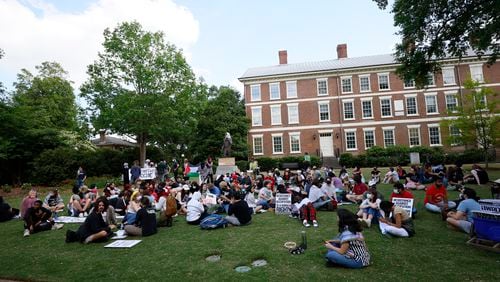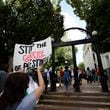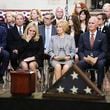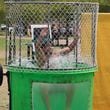One of the most sweeping surveys of sexual assaults and misconduct on American college campuses confirms incidents are common and often go unreported.
Nearly half of all respondents in the newly released survey, 47.7 percent, said they were victims of sexual harassment.
Looking only at the responses of undergraduate women, nearly 62 percent reported being sexually harassed, mostly through inappropriate comments about their appearance or sexuality. More than 20 percent reported being the victim of sexual assault and misconduct.
Credit: Maureen Downey
Credit: Maureen Downey
Half of the respondents who said they were victims of sex offenses involving penetration never reported the incident to the administration or police because they did not believe it was serious enough. Many said they didn't speak out because they were “…embarrassed, ashamed or that it would be too emotionally difficult” or “...did not think anything would be done about it.”
The Association of American Universities Campus Climate Survey on Sexual Assault and Sexual Misconduct received responses from 150,000 students on 27 campuses. There were seven Ivy League schools among the 27, as well as top public campuses including the Universities of Michigan, North Carolina, Texas, Florida and Virginia. The Washington Post compiled charts of the rates for the participating campuses with comments from the school leaders on their individual results.
Yale University President Peter Salovey told the Post, "The prevalence of such behavior runs counter to our most fundamental values. It threatens individual students, our learning environment and our sense of community."
Slate's Nora Caplan-Bricker offers a good critique of the findings and smart questions about the disparities by campus, writing, "With that information in hand, and with some further investigation, maybe we could begin to understand why, for example, 19 percent of undergraduate women at Iowa State University and 20 percent at the University of Florida report being victims of some nonconsensual sexual contact, compared to 26 percent at Harvard and 28 percent at Dartmouth. Understanding even subtle differences could help us do something constructive about this universal problem. So far, this study mostly tells us that the problem exists—something we should already know."
Here are excerpts from the official summary of the report:
In the fall of 2014, the Association of American Universities contracted with Westat, a research firm, to work with a university team of researchers and administrators to design and implement the survey, entitled the AAU Campus Climate Survey on Sexual Assault and Sexual Misconduct.
The survey was administered at the end of the spring 2015 semester on the campuses of 27 institutions of higher education, 26 of which are AAU member universities. The survey was designed to assess the incidence, prevalence and characteristics of incidents of sexual assault and misconduct. It also assessed the overall campus climate with respect to perceptions of risk, knowledge of resources available to victims, and perceived reactions to an incident of sexual assault or misconduct.
This study is one of the first to provide an empirical assessment of these questions across a wide range of institutions of higher education. Prior studies of campus sexual assault and misconduct have been implemented for a small number of institutions of higher education or for a national sample of students with relatively small samples for any particular institutions of higher education
Highlights of the results include:
•The percentage of students who report nonconsensual sexual contact varies greatly by the type of sexual contact (penetration or sexual touching) and whether or not it involves physical force, alcohol or drugs, coercion, or absence of affirmative consent.
•The profiles of each institution of higher education are quite different. There is wide variation across institutions of higher education; for most types of sexual assault and misconduct measured on this survey; for various campus climate measures, such as opinions about how problematic it is at the school and how students and university officials might react to an incident.
•The average rates of nonconsensual sexual contact by physical force or incapacitation across all 27 institutions of higher education are as high or slightly higher than those revealed in prior surveys.
•Rates of sexual assault and misconduct are highest among undergraduate females and those identifying as transgender, genderqueer, non-conforming, questioning, and as something not listed on the survey.
•The risk of the most serious types of nonconsensual sexual contact, due to physical force or incapacitation, decline from freshman to senior year. This decline is not as evident for other types of nonconsensual sexual contact
•Nonconsensual sexual contact involving drugs and alcohol constitute a significant percentage of the incidents.
•A relatively small percentage (e.g., 28 percent or less) of even the most serious incidents are reported to an organization or agency (e.g., Title IX office; law enforcement)
•More than 50 percent of the victims of even the most serious incidents (e.g., forced penetration) say they do not report the event because they do not consider it “serious enough.”
•A significant percentage of students say they did not report because they were “…embarrassed, ashamed or that it would be too emotionally difficult” or “...did not think anything would be done about it.”
•Significantly more than half of the victims of nonconsensual sexual contact who reported the incident to an agency or organization said their experience with the agency or organization was very good or excellent along several criteria.
•When asked what might happen when a student reports an incident of sexual assault or misconduct to a university official, about half say that it is very or extremely likely that the university will conduct a fair investigation. The percentage is lower for those groups that are most likely to report victimization (i.e., females and those identifying as TGQN). Similar percentages are evident for opinions about other types of reactions by the university (e.g., officials would take the report seriously; protect the safety of the student; take action against the offender).
•A little less than half of the students have witnessed a drunk person heading for a sexual encounter. Among those who reported being a witness, most did not try to intervene.
•As noted above, the study found a wide range of variation across the 27 institutions of higher education in the rates of sexual assault and misconduct, as well as the climate measures. However, the analyses did not find a clear explanation for why there is such wide variation. Some university characteristics, such as size, were correlated with certain outcomes. But the correlation was not particularly strong. An analysis of the possibility the estimates were affected by non-response bias found that certain types of estimates may be too high because non-victims may have been less likely to participate. This might have contributed to some of the differences observed between schools, although indications are that this was not a large effect.







